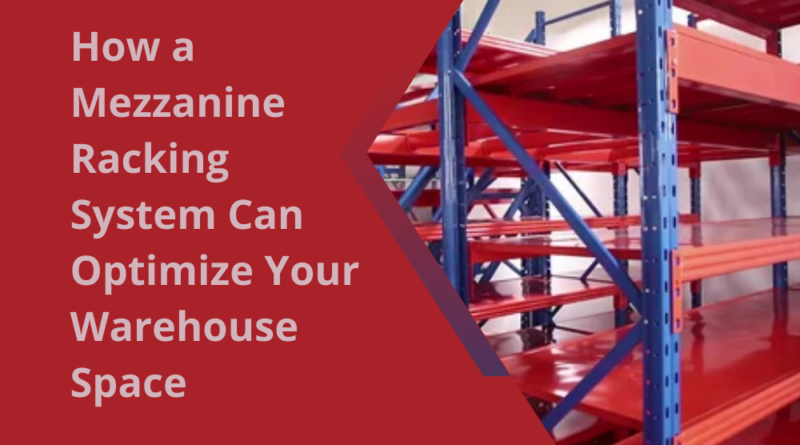How a Mezzanine Racking System Can Optimize Your Warehouse Space
Warehouses are critical components of many businesses, providing essential space for storing inventory, equipment, and other valuable items. As businesses grow, so does the need for more storage space. However, expanding a warehouse horizontally can be costly and impractical. This is where a mezzanine racking system comes into play. In this blog, we will explore how a mezzanine racking system can optimize your warehouse space, enhance efficiency, and ultimately boost your business’s productivity.
Understanding Mezzanine Racking Systems
What is a Mezzanine Racking System?
A mezzanine racking system is a raised platform installed between the floor and the ceiling of a warehouse. It creates an additional level of storage space within the existing structure. Think of it as adding a second floor inside your warehouse without the need for extensive construction. These systems are designed to maximize vertical space, allowing you to make the most of your warehouse’s height.
Note:- Ready to optimize your warehouse space and boost productivity? Don’t wait any longer! Implementing a mezzanine racking system can revolutionize your storage solutions, maximize efficiency, and drive your business forward. Contact our experts today to learn more about how a mezzanine racking system can transform your warehouse. Click here to get started!
Components of a Mezzanine Racking System
A mezzanine racking system consists of several key components:
- Support Columns: These are vertical structures that bear the load of the mezzanine level. They are typically made of steel and are placed strategically to ensure stability.
- Beams and Joists: These horizontal elements form the framework of the mezzanine floor. They provide support and distribute the weight evenly.
- Decking: The surface of the mezzanine floor, which can be made of various materials such as steel, wood, or composite panels. The choice of material depends on the type of goods being stored.
- Stairs and Ladders: Access to the mezzanine level is provided by stairs or ladders. Safety features such as handrails and non-slip surfaces are essential.
- Safety Barriers: To prevent accidents, safety barriers or guardrails are installed around the edges of the mezzanine.
Benefits of Mezzanine Racking Systems
Maximizing Storage Space
One of the most significant advantages of a mezzanine racking system is the ability to maximize storage space. By utilizing the vertical space in your warehouse, you can effectively double or even triple your storage capacity. This is particularly beneficial for businesses with limited floor space but high ceilings.
Cost-Effective Solution
Expanding a warehouse horizontally can be expensive due to construction costs, permits, and disruptions to daily operations. In contrast, installing a mezzanine racking system is a cost-effective solution that minimizes downtime and construction expenses. It allows you to optimize your existing space without the need for a new building.
Improved Organization
A mezzanine racking system can significantly improve the organization of your warehouse. With additional storage levels, you can categorize and separate different types of inventory more efficiently. This leads to better inventory management, reduced clutter, and quicker access to goods.
Enhanced Safety
Safety is a top priority in any warehouse. Mezzanine racking systems are designed with safety features such as guardrails, safety barriers, and non-slip surfaces. These features help prevent accidents and ensure a safe working environment for your employees.
Increased Productivity
By optimizing your warehouse space, a mezzanine racking system can boost productivity. With more organized storage and easier access to inventory, your employees can work more efficiently. This leads to faster order fulfillment, reduced downtime, and improved overall operational efficiency.
Types of Mezzanine Racking Systems
Structural Mezzanine
Structural mezzanines are built with heavy-duty steel columns and beams. They are ideal for warehouses with high ceilings and heavy loads. These mezzanines can support substantial weight and provide a robust and durable solution for additional storage space.
Rack-Supported Mezzanine
Rack-supported mezzanines are integrated with existing pallet racking systems. The racking structure itself supports the mezzanine level, making it a cost-effective and space-efficient solution. This type of mezzanine is suitable for warehouses that already have pallet racking in place.
Shelving-Supported Mezzanine
Shelving-supported mezzanines are similar to rack-supported mezzanines but use shelving units instead of pallet racking. This type of mezzanine is ideal for warehouses that store smaller items and require a high level of organization. The shelving units provide easy access to inventory while maximizing vertical space.
Catwalk Mezzanine
Catwalk mezzanines are designed for warehouses that require access to high-level storage areas. They consist of narrow walkways or catwalks that provide access to shelving or racking systems. Catwalk mezzanines are ideal for picking operations and allow employees to move efficiently between different levels of storage.
Steps to Implement a Mezzanine Racking System
Assess Your Warehouse Needs
Before implementing a mezzanine racking system, it’s essential to assess your warehouse’s specific needs. Consider factors such as the type of inventory you store, the weight of the goods, and the available vertical space. This assessment will help you determine the most suitable type of mezzanine racking system for your warehouse.
Plan the Layout
Once you’ve assessed your needs, the next step is to plan the layout of the mezzanine racking system. This involves deciding where the support columns will be placed, how the beams and joists will be arranged, and the location of access points such as stairs or ladders. A well-planned layout ensures efficient use of space and easy access to inventory.
Obtain Necessary Permits
Depending on your location and the scale of the mezzanine racking system, you may need to obtain permits from local authorities. It’s important to check with your local building department to ensure compliance with safety and building regulations. Failure to obtain the necessary permits can result in fines and delays in the installation process.
Hire a Professional Installation Team
Installing a mezzanine racking system requires expertise and precision. It’s recommended to hire a professional installation team with experience in mezzanine construction. They will ensure that the system is installed correctly, safely, and in compliance with regulations.
Conduct Safety Inspections
Once the mezzanine racking system is installed, conduct thorough safety inspections to ensure that all components are secure and functioning properly. Check for any potential hazards such as loose bolts, unstable support columns, or damaged decking. Regular safety inspections should be conducted to maintain a safe working environment.
Maintaining Your Mezzanine Racking System
Regular Inspections
Regular inspections are crucial to maintaining the integrity and safety of your mezzanine racking system. Schedule routine inspections to check for any signs of wear and tear, damage, or structural issues. Address any problems immediately to prevent accidents and ensure the longevity of the system.
Cleaning and Maintenance
Keep the mezzanine racking system clean and free of debris. Regularly sweep the mezzanine floor and remove any obstructions that could pose a safety risk. Additionally, perform routine maintenance on components such as support columns, beams, and decking to ensure they remain in good condition.
Employee Training
Proper training is essential for employees who will be working on or around the mezzanine racking system. Train employees on safe practices, including how to use stairs or ladders, handle inventory, and identify potential hazards. Well-trained employees contribute to a safer and more efficient working environment.
Load Capacity Management
Ensure that the load capacity of the mezzanine racking system is not exceeded. Overloading the system can compromise its structural integrity and lead to accidents. Clearly mark load capacities on the mezzanine and provide guidelines for employees to follow when storing inventory.
Case Studies: Success Stories of Mezzanine Racking Systems
Company A: Increased Storage Capacity
Company A, a logistics firm, was facing storage capacity issues in their warehouse. By implementing a mezzanine racking system, they were able to double their storage space without expanding the warehouse footprint. This allowed them to accommodate more inventory, streamline operations, and meet customer demands more efficiently.
Company B: Improved Organization
Company B, an e-commerce retailer, struggled with inventory organization in their warehouse. The installation of a shelving-supported mezzanine racking system enabled them to categorize and separate products effectively. This led to improved inventory management, faster order fulfillment, and increased customer satisfaction.
Company C: Cost-Effective Solution
Company C, a manufacturing company, needed to expand their storage space but faced budget constraints. They opted for a rack-supported mezzanine racking system, which integrated seamlessly with their existing pallet racking. This cost-effective solution provided the additional space they needed without the expense of a new building.
Conclusion
A mezzanine racking system is a powerful tool for optimizing warehouse space. By utilizing vertical space, it allows businesses to maximize storage capacity, improve organization, enhance safety, and increase productivity. Whether you operate a small warehouse or a large distribution center, a mezzanine racking system can provide a cost-effective solution to your storage challenges. By following the steps outlined in this blog and maintaining the system regularly, you can ensure a safe, efficient, and productive warehouse environment.
Read more informative blog at nichenest.




